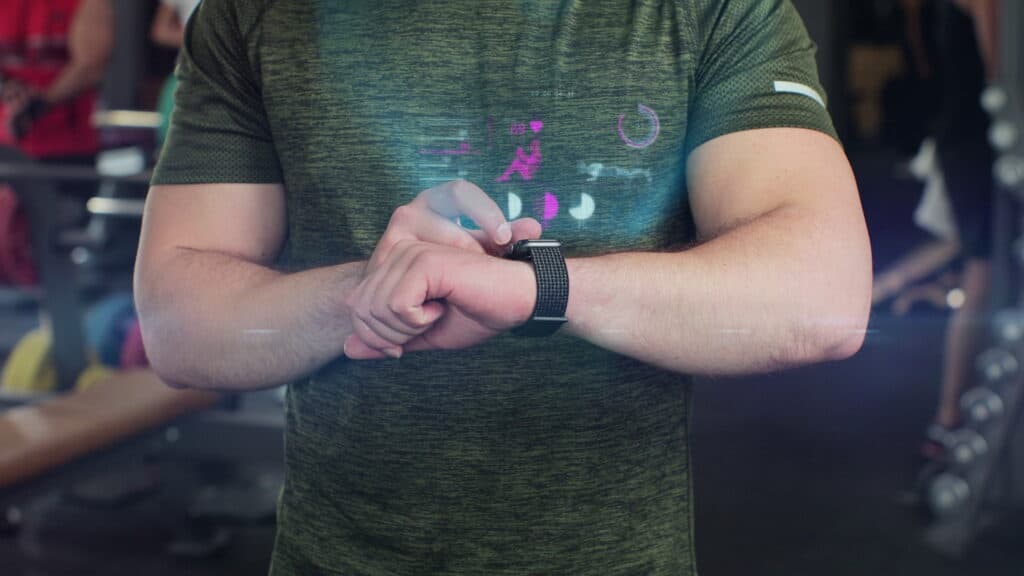Cardiovascular exercise is key to achieving and maintaining health and fitness. Determining the optimal duration, intensity, and frequency of cardio sessions can be guided by metrics such as heart rate (HR), heart rate variability (HRV), and heart rate recovery (HRR). Here, we explore evidence-based guidelines for weekly exercise duration, intensity for health and weight loss, and the role of HRV and HRR in tracking cardiovascular fitness.
How Long Should You Perform Cardio Each Week?
The American Heart Association (AHA) and World Health Organization (WHO) recommend at least 150-minutes per week of moderate-intensity aerobic exercise. You also have the option of performing 75-minutes per week of vigorous-intensity cardio to achieve those health benefits with longer duration. In doing so, improved heart health, reduced risk of chronic diseases, and enhanced mental well-being are just a few of the benefits. Training sessions can be broken down into manageable sessions, like 30-minutes per day for five days a week, which has been shown to lower blood pressure, reduce LDL cholesterol, and improve overall cardiovascular function.
For weight-loss, research suggests increasing the duration to at least 300-minutes per week of moderate-intensity exercise. This equates to about an hour of cardio five days a week. Studies find that while exercise alone may not lead to rapid weight loss without dietary changes, it supports sustainable weight management and aids in preventing the regain of lost weight.
Health and Weight Loss: Percentage of Maximum Heart Rate (MHR)
A useful way to gauge exercise intensity is through your percentage of maximum heart rate (MHR). Maximum heart rate is typically estimated by subtracting your age from 220. Based on this, training at different HR zones offer varied benefits:
- Moderate-intensity: 50–70% of MHR is ideal for health benefits, improving cardiovascular endurance, and supporting weight maintenance. At this intensity, you should be able to hold a conversation without gasping for breath.
- Vigorous-intensity: 70–85% of MHR is optimal for cardiovascular fitness improvements, fat oxidation, and weight loss. Exercising at this level can help create a larger calorie deficit, supporting more effective weight loss and cardiovascular conditioning .
Heart Rate Variability: What is it and Why is it Important?
Heart rate variability (HRV) refers to the variation in time between heartbeats, controlled by the autonomic nervous system. A high HRV is associated with greater adaptability and resilience to stress, while a low HRV can indicate poor recovery, stress, or overtraining.
Tracking HRV offers insights into your overall cardiovascular health. For example, consistent training with adequate rest often raises HRV over time, while sudden drops may indicate the need for recovery or lower-intensity training sessions. Monitoring HRV can be especially useful for athletes who need to optimize training load or for individuals managing stress levels. According to a study in the European Journal of Applied Physiology, regular moderate-to-vigorous exercise is associated with improved HRV in both young and older adults, indicating better heart health and reduced risk of cardiovascular disease.

Heart Rate Recovery (HRR): An Indicatiovascular Fitness
Heart rate recovery (HRR) is the rate at which heart rate declines after stopping exercise. Research shows that a faster heart rate recovery post-exercise is linked to better cardiovascular fitness and a reduced risk of cardiac events.
Generally, a drop of 12 beats or more within a minute after stopping exercise is considered a good indicator of cardiovascular health. An HRR of less than 12 beats per minute may indicate lower fitness levels and a higher risk of cardiac issues. This measure is valuable in tracking fitness progress, as improved cardiovascular fitness correlates with a faster return to resting heart rate levels post-exercise.
The Role of Cardiovascular Training in Improving HRV and HRR
Regular aerobic exercise can enhance both HRV and HRR, contributing to improved cardiovascular and autonomic function. In a study published in the American Journal of Cardiology, researchers found that a 12-week cardio program significantly improved HRV and reduced the time needed for heart rate to recover post-exercise in previously sedentary adults. This suggests that not only is aerobic training beneficial for heart health, but it also enhances the body’s stress response and recovery mechanisms.
How to Use Heart Rate: Subtract your age from 220 to estimate your MHR.
- Determine your target heart rate zones:
- For moderate-intensity exercise, aim for 50–70% of your MHR.
- For vigorous-intensity exercise, aim for 70–85% of your MHR.
- Monitor HRR: Measure your heart rate immediately after stopping exercise and again after one minute. If your heart rate drops by at least 12 beats, this is a positive indicator of cardiovascular fitness.
- Track HRV for recovery: Use HRV tracking devices to gauge recovery. Higher HRV generally signals better fitness and recovery capacity, while a drop may suggest the need for rest or lighter exercise.
Conclusion
Understanding and monitoring heart rate metrics—such as percentage of MHR, HRV, and HRR—can help optimize your cardio workouts for both health and weight loss. To achieve health benefits, aim for at least 150-minutes of moderate cardio each week (or 75 minutes of vigorous), while 300-minutes may be necessary for weight loss. Exercising within 50–85 percent of MHR is ideal for different fitness goals, and paying attention to HRV and HRR can give you valuable insights into recovery and cardiovascular fitness. Using these measures, you can better tailor your workouts to maximize both short- and long-term health benefits.
Stay Strong Together
If you’re serious about nutrition, building muscle and reaching your fitness goals, the Jefit app is the perfect tool to help get you there. With over 20 million downloads and more than 12 million bodybuilders using the app to track their workouts, Jefit is the ultimate strength training companion. Rated as the 2023 Best App and featured by top publications like Men’s Health, PC Magazine, and USA TODAY. Jefit boasts 42,000+ five-star ratings for its user-friendly design and comprehensive features. Whether you’re focused on protein intake, building strength, or tracking your progress, Jefit has everything you need to succeed. Download Jefit today and join millions of fitness enthusiasts transforming their bodies!
References
- American Heart Association. (2021). Recommendations for Physical Activity in Adults.
- Pescatello, L.S., et al. (2019). Exercise and hypertension: Applying the ACSM’s guidelines. Journal of Cardiopulmonary Rehabilitation and Prevention.
- Swift, D.L., et al. (2014). The role of exercise and physical activity in weight loss and maintenance. Progress in Cardiovascular Diseases.
- Garber, C.E., et al. (2011). Quantity and quality of exercise for developing and maintaining fitness in healthy adults. Medicine & Science in Sports & Exercise.
- Shaffer, F., & Ginsberg, J.P. (2017). An overview of heart rate variability metrics and norms. Frontiers in Public Health.
- Soares-Miranda, L., et al. (2014). Physical activity and heart rate variability in older adults. Circulation.
- Cole, C.R., et al. (1999). Heart rate recovery immediately after exercise as a predictor of mortality. New England Journal of Medicine.
- Sandercock, G.R., et al. (2005). Cardiorespiratory fitness, HRV, and autonomic responses. European Journal of Applied Physiology.
- Maximum Activation: Bear Crawl, Plank, & Dead Bug - April 2, 2025
- Boost Your Posterior Strength with 3 Effective Jefit Exercises - March 31, 2025
- 8 Underrated Stretches to Improve Your Deadlift Performance - March 28, 2025
